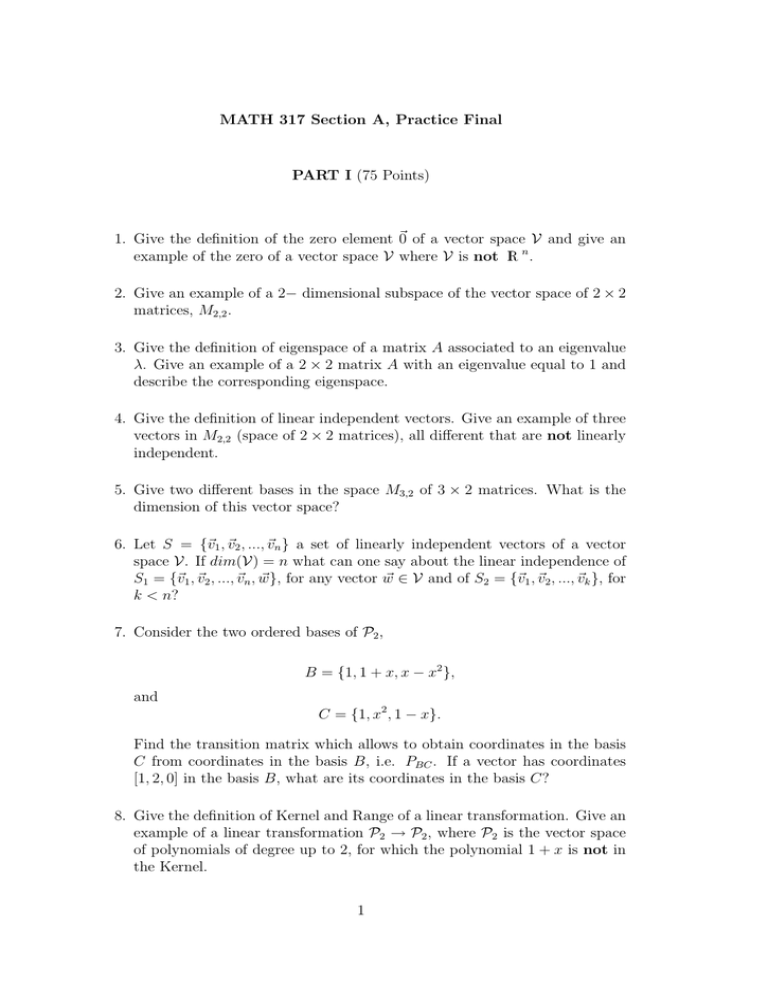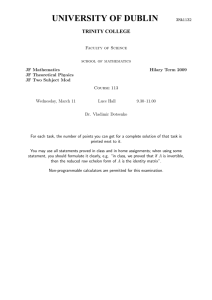MATH 317 Section A, Practice Final PART I (75 Points)
advertisement

MATH 317 Section A, Practice Final
PART I (75 Points)
1. Give the definition of the zero element ~0 of a vector space V and give an
example of the zero of a vector space V where V is not R
I n.
2. Give an example of a 2− dimensional subspace of the vector space of 2 × 2
matrices, M2,2 .
3. Give the definition of eigenspace of a matrix A associated to an eigenvalue
λ. Give an example of a 2 × 2 matrix A with an eigenvalue equal to 1 and
describe the corresponding eigenspace.
4. Give the definition of linear independent vectors. Give an example of three
vectors in M2,2 (space of 2 × 2 matrices), all different that are not linearly
independent.
5. Give two different bases in the space M3,2 of 3 × 2 matrices. What is the
dimension of this vector space?
6. Let S = {~v1 , ~v2 , ..., ~vn } a set of linearly independent vectors of a vector
space V. If dim(V) = n what can one say about the linear independence of
S1 = {~v1 , ~v2 , ..., ~vn , w},
~ for any vector w
~ ∈ V and of S2 = {~v1 , ~v2 , ..., ~vk }, for
k < n?
7. Consider the two ordered bases of P2 ,
B = {1, 1 + x, x − x2 },
and
C = {1, x2 , 1 − x}.
Find the transition matrix which allows to obtain coordinates in the basis
C from coordinates in the basis B, i.e. PBC . If a vector has coordinates
[1, 2, 0] in the basis B, what are its coordinates in the basis C?
8. Give the definition of Kernel and Range of a linear transformation. Give an
example of a linear transformation P2 → P2 , where P2 is the vector space
of polynomials of degree up to 2, for which the polynomial 1 + x is not in
the Kernel.
1
9. Consider the linear transformation L : P1 → P1 , where P1 is the vector
space of polynomials of degree up to 1, and L is given by
L(p) = p + p0 .
Fix a basis in P1 and determine the matrix representation of the linear
operator L in this basis.
10. Consider the linear operator L : R
I n
by
1
AS = 1
2
→ R
I n defined, in the standard basis,
0 −1
0 1 .
1 1
Consider the alternative basis
1
0
0
B = { 0 , 1 , 1 },
0
−1
1
and give the expression of the same linear operator in the basis B.
11. Give the statement of the dimension theorem and illustrate the theorem
with an example of a linear operator with one-dimensional Kernel and onedimensional range.
12. Give the definition of one-to-one transformation and the definition of onto
transformation. Give the statement of a theorem which relates the fact that
a linear transformation is one to one to the Kernel of that linear transformation.
13. Consider the linear operator
L : M2,2 → M2,2 ,
where M2,2 is the space of 2 × 2 matrices. L defined by
L(A) = A − AT .
What are the eigenvalues of this operator? What are the eigenspaces? Is
this operator diagonalizable? and why?
14. Give the definition of orthogonal and orthonormal vectors in R
I n . Give
three examples: 1) Two vectors in R
I 3 which are not orthogonal 2) Two
3
vectors in R
I which ar orthogonal but not orthonormal. 3) Two vectors in
R
I 3 which are orthonormal.
2
15. Give the definition of orthogonal matrix and a 2 × 2 example different from
the identity matrix.
PART II (25 Points)
Problem 1 (15 points) Use the Gram-Schmidt process to find an orthogonal
basis of
1
1
1
1 0 1
span{ , , }
0 0 1
0
1
1
Problem 2 (10 points) Find the Least Squares best solution of the inconsistent system
AX = B,
where
2 1 3
A = 1 0 1,
0 1 1
3
1
B = 0.
0





